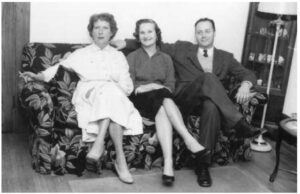THE WYCHERLY WOMAN Part Nineteen
Spoiler Alert

IT’S NOT UNBEIEVALBLE; IT REALLY HAPPENENED
And Other Fallacies of Fiction
The Wycherly Woman rises or falls, as a work of art, on whether you can accept Phoebe’s impersonation.
There are two elements: first, would a college-age girl be willing to pretend to be her mother; and second, could she pull it off?
Macdonald does a convincing job with the first part. Phoebe’s understandable confusion about Catherine’s reference to “your father,” and her strong attachment to Homer, creates a plausible motivation, given Phoebe’s troubled mental state and her very real sense of responsibility for what happened. If she had just kept her big mouth shut, the divorce wouldn’t have happened and her mother wouldn’t be dying. It’s not a stretch for Phoebe to believe Homer killed her mother after the violent scene in Homer’s stateroom earlier that day after all the antagonism surrounding the divorce. And Merriman is exactly the kind of manipulative personality who can exploit Phoebe’s vulnerability.
(You will note that I have glossed over a minor implausibility, that Catherine could have been more specific about her killer. One of the good things about dying, at least in detective fiction, is that the victim gets some slack. The core of the mystery is withheld or ambiguous information. If Catherine’s word choice in her last moments offends you, perhaps you shouldn’t be reading mysteries.)
The second part of the impersonation, the plausibility, is the interesting one. It stopped Peter Wolfe and plenty of others in their tracks. But let’s examine it closely:
- This is not a lifetime impersonation; it’s a short con that needs to be convincing only at the time of the real estate settlement. That Phoebe also pulls off the impersonation to cash a couple of alimony checks is secondary and is important mainly because it gives her a chance to practice before the big day.
- Real estate settlements are run either by lawyers or a title company; no one at the settlement would have met Catherine Wycherly and no one suspects what is going on.
- Phoebe’s role as the seller is simply to sign the deed and any other documents. She’s had two months to practice her mother’s signature.
- Since he had access to Catherine’s house and personal effects, Merriman had Catherine’s driver’s license. Archer notes that Catherine’s license is in the purse of the woman he meets at the Hacienda Inn. Starting in 1958, California introduced black and white photos on driver’s licenses (thank you, Google) so Merriman needed to create a decent resemblance between Phoebe and the postage stamp size photo of her mother. The kind of resemblance between identical twins wasn’t necessary. It was sufficient that it fool a settlement clerk who was expecting that the person handing over the license was the person in the photo.
Back to Creative Writing 101
A story is not believable merely because it’s based on a real incident. Credibility in fiction depends on what the writer delivers between the four corners of the page. And this is where Peter Wolfe and others have a legitimate objection.
Phoebe Wycherly is closely modeled on Linda Millar. Both were deeply troubled young women who disappeared for a period, and both could appear much older than their real age. As early as 15, Linda started wearing her mother’s clothes and dressing older. She did this in part to buy alcohol but there may have been darker reasons related to her fragile sense of identity. There is a famous picture of the Millars where Linda looks like a younger sister of her mother. But the fact that Linda Millar could have pulled it off doesn’t necessarily convince us of Phoebe Wycherly’s story. It only tells us where Macdonald got his inspiration.
As we have noted, this book was not one of Macdonald’s favorites, and he never included it in later omnibus editions. I wonder if his discomfort was purely artistic or whether he came to feel that he had exploited Linda’s troubles. One has to wonder what Linda thought of the character of Phoebe. Linda was deeply troubled but she was also very bright.
For those of you interested in delving deeper into Linda Millar’s life, there is a great deal of material that Tom Nolan left out of his biography out of respect for the family. The full story is much sadder and uglier than the one Nolan presented:
www. https://crimereads.com/linda-interrupted/
Recent Comments